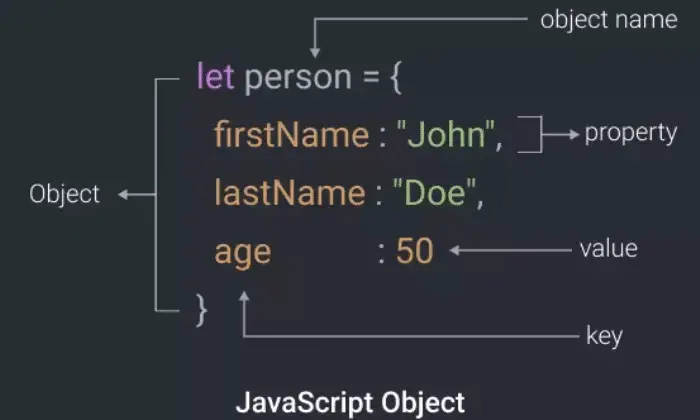JavaScript objects are a fundamental concept in the language and are used to store and organize data. They are similar to real-world objects in that they have properties and methods which can be used to manipulate and access the data they contain. This article will explore what objects are in JavaScript, how they are created, and how they can be used to structure and manage data, including techniques for Using JQuery In A JavaScript File.
See Also: Best Tools For Beautifying Or Unminifying HTML, CSS, JS, XML, And JSON
Table of Contents
Object in JavaScript
An object in JavaScript is a collection of properties, possibly other objects or simple values (such as strings or numbers). You may retrieve property values by utilizing the dot notation (e.g., Object. property) or square bracket notation (e.g.,` Object [‘property’]`). Properties are identifiable by a string key.

There are various ways to construct objects in JavaScript. The literal object notation, which consists of a collection of key-value pairs surrounded in curly braces, is one approach.
For example:
let person = {
firstName: 'Mahi',
lastName: 'Sahni',
age: 30
};
Another way to create an object is by using the object constructor function, the Object () function.
For example:
let person = new Object(); person.firstName = 'Mahi'; person.lastName = 'Sahni'; person.age = 30;
Objects can also be created using object-oriented patterns such as constructor functions, which create and initialize new objects.
For example:
function Person(firstName, lastName, age) {
this.firstName = firstName;
this.lastName = lastName;
this.age = age;
}
let Mahi = new Person('Mahi', 'Sahni', 30);
See Also: What is the Proper Operator for “Not Equals” in JavaScript?
What is JavaScript Object?
JavaScript objects can also define custom data types by creating objects with specific properties and methods. This is done by defining a constructor function and using the `new` keyword to create an object instance. For example,

function Person(firstName, lastName, age) {
this.firstName = firstName;
this.lastName = lastName;
this.age = age;
this.getFullName = function() {
return this.firstName + ' ' + this.lastName;
}
}
let Mahi = new Person('Mahi', 'Sahni', 30);
console.log(Mahi.getFullName());
How to create JavaScript Object?
JavaScript also provides a way to create objects that inherit properties and methods from another object, known as prototypal inheritance. In JavaScript, each Object has a prototype, which is another object. When attempting to access a property, JavaScript first checks the Object itself, and if it cannot locate the property, it searches for it on the Object’s prototype.

. This process continues until it reaches the Object’s prototype chain, which ends with the `Object. Prototype` Object.
JavaScript provides an `Object. Create ()` method for creating objects with a specific prototype, like so:
let personProto = {
getFullName: function() {
return this.firstName + ' ' + this.lastName;
}
};
let Mahi = Object.create(personProto);
Mahi.firstName = 'Mahi';
Mahi.lastName = 'Sahni';
console.log(Mahi.getFullName());
In summary, JavaScript objects are collections of properties. The properties are accessed using dot notation(Object. property) or bracket notation(Object [‘property’]). Objects can be created using object literals, object constructor functions, and constructor functions with inheritance. They can encapsulate state and activity and construct unique data types.
In addition to properties and methods, JavaScript objects have a few unique properties and methods built into the language. These include the “constructor” property, a reference to the function used to create the Object, and the “toString” method, which returns a string representation of the Object.
FAQS
How are objects created in JavaScript?
Objects can be created in JavaScript using object literals, enclosed in curly braces, and consisting of key-value pairs. They can also be created using constructors or classes, which provide a blueprint for creating objects with specific properties and methods.
What are the methods in JavaScript objects?
Methods in JavaScript objects are functions that are stored as part of the Object and can be called using dot notation. Methods can be used to perform actions on the Object or to return values based on the Object's properties.
How are properties and methods accessed in JavaScript objects?
Properties and methods in JavaScript objects are accessed using dot notation or bracket notation. Dot notation is used to access properties and methods with a known name, while bracket notation is used to access properties and methods with a variable name.
What is the 'this' keyword in JavaScript objects?
The 'this' keyword in JavaScript objects refers to the Object the method or property is being called on. It can be used to access other properties and methods of the Object.
How are objects copied and cloned in JavaScript?
Objects can be copied in JavaScript using the spread operator or Object.assign() method. Cloning an object involves creating a new object with the same properties and values as the original Object, which can be done using various techniques such as the Object.create() method.
Conclusion
In conclusion, JavaScript objects are a fundamental language concept that stores and organizes data. They can be created using the literal object notation or a constructor function. They can have properties and methods that can be in use to manipulate and access the data they contain. Objects can structure and manage data, create reusable code, and even inherit properties and methods from other objects.
JavaScript’s Date object provides powerful functionality for manipulating dates. It allows developers to perform various operations, including converting strings to dates in the DD-MM-YYYY format or Convert An Array To An Object In JavaScript.
In conclusion, learning to read a JSON file in JavaScript opens up possibilities for creating data-driven applications that deliver rich and engaging user experiences.
See Also: How To Automatically Export Figma To HTML Code And CSS
Hi, I’m Geoff. I design. I develop. I do lots of things in between. What that really boils down to is that I make websites.